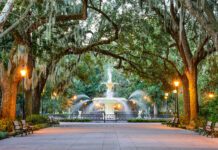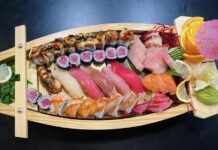Mad About Mod
2014 Oklahoma Hall of Fame Induction Ceremony

Peggy V. Helmerich Distinguished Author Award Dinner
Scene

The Basket Ball 2015
Meal Of Good Fortune
Eating a big plate of greens and black-eyed peas may not appeal to everyone, but for millions of Americans – particularly in the south – these foods, traditionally served with pork on New Year’s Day, represent good luck, prosperity and fortune.
Hosting friends and family for a New Year’s Day feast can be a fun way to celebrate the upcoming year and also keep tradition alive. Keep the menu simple, and focus on the
classics. Just be sure to have plenty of cornbread to serve alongside the ham, greens and black-eyed peas.
Maple and Brown Sugar Glazed Ham

Recipe courtesy Farmer’s Almanac.
- 1 fully cooked ham, about 6 to 8 pounds
- 1/2 c. pure maple syrup
- 1/2 c. brown sugar
- 1/2 c. apple juice
- 1 tbsp. brown or Dijon mustard
- Dash cinnamon and ginger or allspice
Place ham, fat side up, on rack in foil-lined roasting pan; score fat and stud with cloves, if desired. Bake at 325 degrees for approximately 18 minutes per pound, until meat thermometer reads 148 degrees. Combine glaze ingredients in saucepan; boil approximately two minutes. Twenty minutes before ham is done baking, spoon about half the glaze over top of ham, then about 10 minutes before done, spread remaining glaze over ham.
Black-eyed Pea Salad

- 1/2 medium red onion, finely chopped
- 1 small red bell pepper, finely chopped
- 1 jalapeno, finely chopped
- 2 tbsp. chopped green onions
- 2 tbsp. chopped fresh parsley leaves
- 2 (15-ounce) cans black-eyed peas, drained
- 1/4 c. unseasoned rice wine vinegar
- 1/4 c. canola oil
- 1/2 tsp. sugar
- salt and freshly ground black pepper
Combine the first six ingredients in a bowl. In a separate small bowl, whisk together the rice wine vinegar, canola oil, sugar and salt and pepper. Toss all together and let marinate for up to 8 hours in the refrigerator before serving.
In The Raw


The sushi-serving staple that originated on Brookside has now become a statewide favorite. In The Raw boasts a location in Oklahoma City’s popular Bricktown district, as well as two locations in Tulsa and one in Broken Arrow. In an effort to further wow diners, the Brookside location now offers brunch. Favorites are given an Asian flair, like the sake poached king salmon served with lemon-dill yogurt sauce and crostini, as well as the raw gulf oysters and select sushi rolls. Eating from the buffet allows diners to sample lots of other favorite dishes, including buttermilk biscuits slathered with southern style sausage gravy and an omelet with lump crab, tomato, spinach and avocado-cilantro sauce. And what brunch is complete without a little booze? Bloody Marys, mimosas, Irish coffee and other cocktails are on the menu at ITR. 3321 S. Peoria Ave., Tulsa. www.intherawsushi.com
Urban Johnnie


The name “Johnnie” in Oklahoma City evokes images of juicy burgers piled high with shredded cheese, pickles, lettuce, tomato and onions. Indeed, when founder Johnnie Haynes opened his first Johnnie’s Charcoal Broiler in Oklahoma City more than 40 years ago, the goal was simple: Provide charcoal-grilled burgers that are hearty, tasty and affordable.
Haynes’ goal was realized; the Oklahoma City area now boasts seven Johnnie’s locations.
Urban Johnnie is the latest incarnation in the Johnnie’s empire. The restaurant, located in the city’s trendy Deep Deuce district, offers a menu that is wide-ranging and upscale. Soup and salad, tacos, sandwiches and, of course, burgers are all on the menu. Four different burger patties are available: beef, chicken, crab cake and veggie. Gourmet burger toppings include blue cheese, roasted poblano peppers, mushrooms, hummus, vegetarian chili and fried egg. Highlights of the menu are the pot roast, served with roasted vegetables and mashed potatoes; chicken fried chicken, served with mashed potatoes; and, of course, Johnnie’s Cheese Theta. This favorite is comprised of a beef patty, shredded American cheese, hickory sauce, house-made pickles and mayonnaise. It’s a crowd-pleaser made famous by the original Johnnie’s more than 40 years ago. 121 NE Second St., Oklahoma City. www.urbanjohnnie.com
Nhinja Sushi & Wok


Photo by Brent Fuchs.
Several years ago, Kang and Mary Nhin opened their first Nhinja Sushi & Wok in Oklahoma City. With a goal of providing high quality, healthy food in a fast-casual environment, the concept of Nhinja quickly took off in the metro area, and several more locations were opened. Today, Nhinja Sushi & Wok operates five establishments, including the newest one located in Tulsa. The menu at all locations is the same: Traditional Asian staples such as miso soup, seaweed salad, rice and noodle bowls and, of course, sushi. Nhinja’s take on the roll is decidedly non-traditional but nonetheless adventurous. The JoJo is made of grilled steak and asparagus topped with eel sauce, while the Fish Lips includes tuna, salmon, yellowtail or crabstick. The Thunder, homage to Oklahoma City’s favorite sports team, is a concoction of tempura shrimp, avocado, crabsticks and spicy mayo. Five locations statewide. www.nhinja.com – Jami Mattox
Chateau Country

Extravagant châteaux and country villages standing along ancient waterways mark France’s Loire Valley as a must-visit destination on any French vacation. While Paris and the French Riviera may get all the holiday headlines, tourists who roam the region are rewarded with royal residences and a slice of French country life.
Nestled along the Loire River, the town of Amboise is a handy base for touring the area. Just two hours southwest of Paris by train, Amboise and the surrounding countryside make for a slow-paced escape from the big city frenzy.

The tourism highpoint in Amboise is the royal Château d’Amboise. Rising mightily above the valley below, the château’s buildings date from the 15th and 16th centuries. A former residence of kings, the château’s terraces and ramparts offer commanding panoramic views of the river and the town. Among the château’s highlights are the Gothic spire of the St. Hulbert Chapel, the council chamber, King Henri II’s chamber and the Orléans chamber.
Just a short walk from the royal château is Clos Lucé, the home of Leonardo da Vinci, who died in Amboise in 1519. His final residence is home to an exhibit celebrating his life and work.
While Amboise is known for its royal château and as da Vinci’s final home, a visitor can easily find other opportunities to explore the narrow and winding streets of the old town. Along the road from the royal château to Clos Lucé are numerous cave dwellings, former limestone quarries that have been fashioned into tiny homes. The pedestrian commercial center houses shops and cafes. An evening stroll across the bridge to the Ile d’Or provides views of the lighted château looming high above the river.
Amboise is also home to a bustling Sunday market, one of the largest in the region, which draws tourists and locals alike. With vendors peddling everything from leather belts to live chickens, the market is a carnival of sights, sounds and smells.
With many majestic châteaux dotting the valley’s landscape, it can be hard to choose which to visit. While a true architecture or history buff may want to rent a car in order to visit many of the fine estates in the region, a guided day tour is likely the easiest route for the casual tourist. Numerous companies operate from Amboise and visit a sampling of châteaux in the course of a day. The region also boasts several vineyards, and tours and wine tasting opportunities abound.

The grandest of the Loire châteaux, Chambord is a three-story goliath. With more than 400 rooms and almost 300 fireplaces, the château’s rooftop is a mass of chimneys, domes and spires. Chambord also boasts almost 80 staircases, including a fascinating double-helix staircase, which was an architectural marvel of its time.
Constructed in the 16th century, the Château de Chenonceau, quite literally, straddles the River Cher. The château’s gallery, which spans almost 200 feet across the river, was built atop a bridge in the late 1500s. Unexpectedly, the château’s kitchens are located in the base of the bridge piers built into the river. Chenonceau’s rooms are elegantly decorated and display a fine collection of furnishings and tapestries.
Built on an island in the Indre River, the Château Azay-le-Rideau could not be more fanciful. Pointed towers and lacey stonework are reflected in the water, an effect intentionally created by restricting the river’s flow to create a water mirror, highlighting Château Azay-le-Rideau’s architectural splendor.
The château at Villandry is best known for its acres of elegantly manicured gardens. Designed in intricate geometric patterns, Villandry’s gardens are an explosion of color and coordination. With everything from shrubs and hedges to flowering plants and vegetables, these gardens are a spectacular sight.

Back in Amboise, lodgings are plentiful, including the 17th-century manor house, Le Clos d’Amboise. Situated just outside the tourist zone, Le Clos d’ Amboise allows for an easy stroll to local restaurants and shops without the bustling noise of the city center. Rooms are available in the manor house itself or in the home’s renovated horse stables. The back of the hotel hides a peaceful courtyard with landscaped gardens and a heated pool.
One simply cannot visit France without sampling the local delicacies. Several restaurants huddle at the base of the chateau and offer tasty local dishes with views of the chateau looming above. Enjoy the escargot and foie gras while taking in the fine French atmosphere.
With its magnificent châteaux, royal history and the crooked lanes of its villages and towns, the Loire Valley is sure to captivate even the most-traveled visitor.





































































